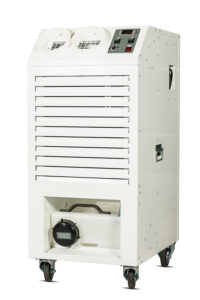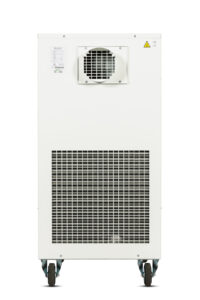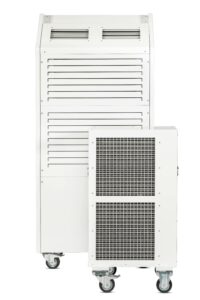As the mercury starts to rise you’ve decided to buy yourself a portable air conditioning unit to help keep cool.
Before you do you though there a few things to take into consideration. Contrary to popular belief setting up an industrial portable air conditioning unit isn’t always as straightforward as you might think, it isn’t always a case of just sticking it into a room and switching it on. Don’t throw down your arms up in despair just yet though, here in this section we’ve put together a handy little guide of things to consider before you buy and install a portable air conditioning.
Considerations When Buying Portable Air Con Units
Portability – This might sound pretty straightforward, right? Some manufacturers and distributors really push the definition of portable though and some units are definitely more portable than others. Things to consider when deciding on a portable air conditioning unit include the weight of it, ease of movement (does it have castors? Are they swivel or fixed? Are they braked?), size of the unit (can it be easily manoeuvred into position? Will it fit through a door?) All these variables can have a big influence when it comes to your portable air conditioning unitsinstallation.
Noise Level – if the unit is going to be an environment that where noise might be an issue? This could be a quiet office, meeting room or even a living areas, if it then will the sound interfere or will it be too noisy to bear? There’s very little point in making a board room comfortably cool if there’s too much noise in there to hold a meeting. Anyone selling a portable air conditioning unit should be able to provide the dbA sound level of their equipment.
Ventilation – hot air is a by-product of the refrigeration process and therefore almost all portable air conditioning units, with the exception of evaporative coolers, will require some form of external ventilation within reach of the unit. This is a particularly important consideration when it comes to monobloc or exhaust tube units that need some sort of external ventilation, such as a window or ceiling void etc where they can vent the hot air within 3M for the most part. Water cooled split air conditioning will need somewhere where the DX box can go but this could be up to 35M away, so it’s not so much of a problem.
Air Circulation – you can really maximise the efficiency of your portable air conditioning units by considering the air circulation within the environment you’re trying to cool. By simply placing a couple of fans, such as our MB range, around the area you’re trying to cool then you can significantly improve the effectiveness of the portable industrial air conditioning unit whilst also increasing the ‘cooling’ effect, just by using a couple of fans instead of perhaps an extra unit!
Controls – most portable air conditioning units will come with a thermostat and fan speed control allowing you to tailor the performance to your requirements. Others also feature timers that allow you to set when they come on rather than just leave them running 24/7. Even if they don’t then a simple timer plug on the electrical input will do a very similar job.
Energy Efficiency – some portable units are more energy efficient than others and generally speaking the higher the cooling output the more efficient it is, although that is by no means always the case. If you really want to know exactly what the EER (Energy Efficiency Rating) of your unit is then simply divide the BTU (British Thermal Units) of cooling by how many watts it uses. The higher the EER rating the more efficient the unit is. It is also worth noting that more efficient units are often more expensive.
If you’ve only got the cooling output in kW then 1kW = 3412BTU, so simply multiply the kW figure by 3412.
How Much Cooling –Another important aspect to think about is the cooling required for your area. Unfortunately it’s not always quite as simple as just buying or hiring a machine and hoping for the best. The amount of cooling provided by a machine is measured in either BTU’s, or more commonly these days kW’s. There are many, many variables involved in calculating the accurate cooling load required for a space, including but not limited to:
– The size of the room.
– The number of people occupying it
– The amount of heat generating appliances in the room
– How much sunlight the room is exposed to
Handily though we’ve put together a simple, easy to use calculator to help you work out just that. You can find it here.
Installing a Portable Air Con Unit
Having assessed the cooling requirement, reviewed your options and deciding on which air con units best suits your needs it’s time to consider how to install it. In this section we take a look at some of the things that need to be considered when you come to use the unit:
Once you have got your portable air conditioner in the room to be cooled:
1. You’ll need to vent the hot air out of a window or into a ceiling void using the provided ducting, so make sure the unit is sited within reach. Of course you’ll also have to be within reach of a suitable 240V 13A electrical supply.
2. Ensure the units is facing the most effective way e.g not pointing straight at a wall. You’ll also need to make sure there’s enough space around the unit to allow for the powerful fans to suck in the required amount of air, avoid backing it up against a wall or desk.
3. Once you have it in position attach the duct to the top of the unit and place the other end out of the ventilation point you’ve selected. Always keep the duct as straight as possible, bends, kinks and even excess duct will all hinder the machines ability to exhaust the hot air away from the condenser. Not only will this limit the unit’s effectiveness but it could lead to damage not covered by warranty.
4. Some units, generally water cooled split air conditioning unit, come with a condensate pump to dispose of condensate. If you’ve got a more traditional style monobloc unit then it’ll probably have an internal condensate bucket.If you’re not quite sure then checking the user manual will confirm this. If your unit requires an external line connect this to the unit and feed the other end out of the window or down the nearest drain, ensuring of course that the hose never gets higher than the drain point of the unit.
5. Quickly check the units is level and sited on firm ground, if everything is in order you can now switch it on and set it to your desired temperature. Give it five or so minutes for the compressor to kick in and another five minutes to start delivering cool air.
Portable Home Air Conditioning Unit Quick tips:
- Close all windows and doors of the room that’s being cooled, this will increase the air conditioners efficiency and effectiveness. If you don’t the machine will just blow cool air but not bring the overall temperature down.
- Close blinds or curtains when the room is exposed to direct sunlight (east facing in the morning, west in the afternoon and south all day). This helps reduce the effect of passive solar gain as sunlight through a window will increase the temperature of the room naturally putting greater demand on your portable air conditioning system.
Portable Home Air Conditioning Unit Quick tips:
- Close all windows and doors of the room that’s being cooled, this will increase the air conditioners effectiveness.
- Close blinds when the room is exposed to direct sunlight. This will help lower the temperature of the room naturally putting less of a demand on your portable air conditioning system.
- Switch off. A surprising amount of heat is generated by appliances such as TVs, laptops, photocopiers, lights and chargers. Try switching these off if possible during the hottest parts of the day to reduce the load on your portable air conditioning unit.
- Think about adding a fan to aid circulation. Not only will the extra air movement help you feel cooler and reduce the stuffiness of a space, it will also help circulate the air in the room properly which will aid the efficiency and effectiveness of your unit.
There you have it, you should now have a perfectly installed portable air conditioning system cooling what was once a stiflingly hot room. Of course, if you still encounter issues you can drop us a message in the comments below or via our social media channels and we’ll do our best to help you out.
If you are considering purchasing a large portable air conditioning unit give us a call on 01527 830610 or sales@broughtoneap.co.uk for more information on the equipment we can provide. Alternatively take a look at our temporary and emergency portable air conditioning range.
Our site also features details on our full ranges of industrial electric fan heaters, commercial refrigerant dehumidifiers, cooling fans, ventilation fans and portable hot water boilers.


